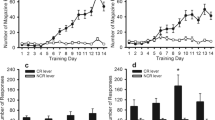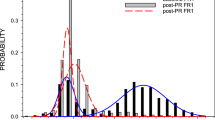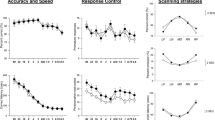Abstract
The effects of amphetamine on the partial punishment effect (PPE) at one trial per day, were examined. Two groups of animals were trained to run in a straight alley. The continuously reinforced (CRF) group received food reward on every trial. The partially punished (PP) group received food reward on every trial but in addition, received footshocks of a gradually increasing intensity in the goal box on a random 50% of the trials. In the test stage, all animals received both food and footshock on each trial. dl-Amphetamine 1.5 mg/kg was administered in a 2 × 2 design, i.e. drug-no drug in training and drug-no drug in test. The partially punished animals exhibited increased persitence in running to the goal box during test, and this “partial punishment effect” was unaffected by amphetamine.
Similar content being viewed by others
References
Anisman H (1976) Effects of scopolamine and d-amphetamine on locomotor activity before and after shock: a diallel analysis in mice. Psychopharmacology 48:165–173
Antelman SM, Chiodo LA (1983) Amphetamine as a stressor. In: Creese I (ed) Stimulants: neurochemical, behavioral and clinical perspectives. Raven Press, New York, pp 269–299
Brookes S, Rawlins JNP, Gray JA (1983) Hippocampal lesions do not alter the partial punishment effect. Exp Brain Res 52:34–40
Brown RT, Wagner AR (1964) Resistance to punishment and extinction training with shock or nonreinforcement. J Exp Psychol 68:503–508
Cook L, Davidson AB (1973) Effects of behaviorally active drugs in a conflict-punishment procedure in rats. In: Garattini S, Mussini E, Randall LD (eds) The benzodiazepines. Raven Press, New York, pp 327–345
Curtis SD, Nonneman AJ (1977) Effects of successive bilateral hippocampectomy on DRL 20 performance in rats. Physiol Behav 19:707–712
Davis N, Brookes S, Gray JA, Rawlins JNP (1981) Chlordiazepoxide and resistance to punishment. Q J Exp Psychol 33B:227–239
Feldon J, Gray JA (1981) The partial reinforcement extinction effect: influence of chlordiazepoxide in septal-lesioned rats. Psychopharmacology 74:280–289
Feldon J, Guillamon A, Gray JA, DeWit H, McNaughton N (1979) Sodium amylobarbitone and response to nonreward. Q J Exp Psychol 31:19–50
Foree DD, Moretz FH, McMillan DE (1973) Drugs and punished responding. II: d-amphetamine-induced increases in punished responding. J Exp Anal Behav 20:291–300
Geller I, Seifter J (1960) The effects of meprobamate, barbiturates, d-amphetamine and promazine on experimentally induced conflict in the rat. Psychopharmacologia 1:482–492
Glowinski J (1970) Effects of amphetamine on various aspects of catecholamine metabolism in central nervous system of the rat. In: Costa E, Garattini S (eds) Amphetamines and related compounds, Raven Press, New York, pp 301–316
Gray JA, Davis N, Feldon J, Owen S, Boarder SR (1981) Stress tolerance: possible neural mechanisms. In: Christie MJ, Mellett PG (eds) Foundations of psychosomatics, Wiley London, pp 153–167
Gray JA, McNaughton N, Holt L, Tsaltas E, Feldon J, Shemer A (1982) The effects of anti-anxiety drugs on tolerance for stress. In: Spiegelstein MY, Levy A (eds) Behavioral models and the analysis of drug action. Elsevier, Amsterdam, pp 175–194
Grilly DM (1977) Rate-dependent effects of amphetamine resulting from behavioral competition. Behav Rev 1:87–93
Heise GA, Milar KS (1984) Drugs and stimulus control. In: Iversen LL, Iversen SD, Snyder SH (eds) Handbook of Psychopharmacology, vol 18. Plenum Press, New York, pp 129–190
Kelleher RJ, Coats L (1961) Effects of d-amphetamine, meprobamate, phenobarbital, mephenesin, or chlorpromazine on DRL and FR schedules of reinforcement with rats. J Exp Anal Behav 4:327–330
Ksir C (1975) Scopolamine and amphetamine effects on discrimination: interaction with stimulus control. Psychopharmacologia 43:37–41
Ksir C, Sleifer B (1982) Drug effects on discrimination at two levels of stimulus control. Psychopharmacology 76:286–290
Laties VG, Wood RW, Rees DC (1981) Stimulus control and the effects of d-amphetamine in the rat. Psychopharmacology 75:277–282
Lyon M, Robbins TW (1975) The action of central nervous system stimulant drugs: a general theory concerning amphetamine effects. In: Essman WB, Valzelli L (eds) Current developments in psychopharmacology, vol 2. Spectrum, New York, pp 79–163
Mackintosh NJ (1974) The psychology of animal learning. Academic Press, London
McMillan D, Leander JD (1975) Drugs and punished responding. V. Effects of drugs on responding suppressed by response-dependent and response-independent electric shock. Arch Int Pharmacodyn Ther 213:22–27
Rawlins JNP, Feldon J, Gray JA (1980) The effects of hippocampectomy and of fimbria section upon the partial reinforcement extinction effect in rats. Exp Brain Res 38:273–283
Sanger DJ, Blackman DE (1976) Rate-dependent effects of drugs: a review of the literature. Pharmacol Biochem Behav 4:73–83
Solomon PR, Moore JW (1975) Latent inhibition and stimulus generalization of the classically conditioned nictitating membrane response in rabbits (Oryctolagus cuniculus) following dorsal hippocampal ablation. J Comp Physiol Psychol 89:1192–1203
Weiner I, Lubow RE, Feldon J (1984) Abolition of the expression but not the acquisition of latent inhibition by chronic amphetamine in rats. Psychopharmacology 83:194–199
Weiner I, Bercowitz H, Lubow RE, Feldon J (1985) Abolition of the partial reinforcement extinction effect (PREE) by amphetamine. Psychopharmacology 86:318–323
Welch BL, Welch AS (1970) Control of brain catecholamines and serotonin during acute stress and after d-amphetamine by natural inhibition of monoamine oxidase: an hypothesis. In: Costa E, Garattini S (eds) Amphetamines and related compounds. Raven Press, New York, pp 415–445
Author information
Authors and Affiliations
Rights and permissions
About this article
Cite this article
Weiner, I., Bercovitz, H. & Feldon, J. Amphetamine does not affect the partial punishment effect (PPE). Psychopharmacologia 88, 119–123 (1986). https://doi.org/10.1007/BF00310526
Received:
Revised:
Issue Date:
DOI: https://doi.org/10.1007/BF00310526




